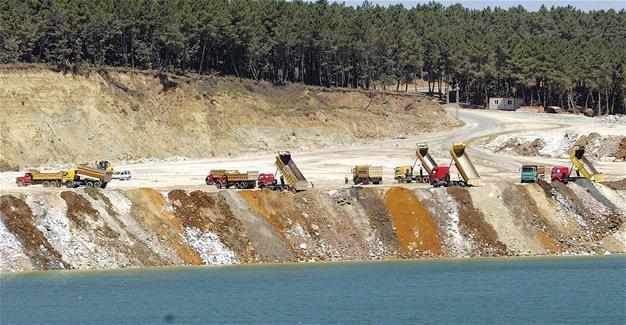Six square kilometers of Istanbul’s land reclaimed from the sea
Banu Tuna – ISTANBUL

Six square kilometers of land have been gained from Istanbul coasts and opened for urban use by filling up the sea. With the acceleration of such infrastructure work at the start of the millennium, professionals are warning about risks.
“We are trying to compensate for the green areas that we cannot protect, by building filled areas we cannot create in the city and the coastline … Otherwise, the natural preservation of coasts in a city with a landscape as unique as the Bosphorus could have even enhanced its beauty,” said the Chamber of Urban Planners of the Union of Architects and Engineers of Turkey (TMMOB).
The land gained by filling up the sea since 2000 accounts for nearly 2.6 square kilometers, or about the size of the total area of Heybeliada, an island off Istanbul, according to calculations and satellite maps.
This is nearly close to the three square kilometers of land filled between 1963 and 2005, according to a former study by Mehmet Gatih Döker of Sakarya University.
The projects included in the post-2000 calculations are the gigantic recreation areas on the Yenikapı neighborhood and Maltepe district, the land reclamation that totally changed the island of Yassıada completely, the additions to the Ataköy Marina, the pedestrian roads at Emirgan and Çubuklu by the Bosphorus, the reclaimed area for the Coast Guard on the bay of Telli Baba, a park on the coast of Avcılar, a fish market that has been transferred from Yenikapı to a new location in Beylikdüzü and a marina constructed in Pendik.
The figures do not include ongoing projects, namely the additions on the Ambarlı Port, the reclaimed area for a tram line on the Golden Horn, a project declared for Beykoz, the ongoing pier construction in Kabataş and the boat lots on the Bosphorus.
“Unfortunately, the [land] filling [on the coasts] are seen as a way to gain land in response to fulfil any public need such as the ongoing [land] filling for the construction of parking lots by the Bosphorus, a mosque in Kadıköy, a treatment facility in Yenikapı, a meeting area in Maltepe and the roads along the Marmara Sea coastline of the city,” the chamber said.
The coastlines are mostly filled to avoid the costs of land expropriation and make use of debris taken from the urban transformation ongoing in Istanbul since 2012. The large reclaimed area in Maltepe and Yenikapı were made with the excavations taken from the urban transformation.
The city planners say the real problem lies in developing project-base and short notice solutions to the requirements of the city.
Authorities say the filled areas may pose risks in possible earthquakes.
“The coasts have been turned into main transport routes that collect people and vehicles. These are all on filled land,” said architect Korhan Gümüş.
“These would be the most hazardous areas during a possible earthquake and tsunami. At certain hours, hundreds of people gather on these areas,” he said.
Reclaimed coastal land also negatively affects the sea’s biodiversity, according to Taner Yıldız of Istanbul University’s Faculty of Aquatic Sciences.
“Some fish species can only exist in certain habitats and depths. If these species live in the shallow waters destroyed by [land] filling, the fish may become extinct since they have no chance to escape,” said Yıldız.
Such changes would also result in shifts in the food chain, he said.
“Some fish species migrate seasonally. The spawning migration of many species is toward shallow waters from deep waters. If the spawning fields of these species are destroyed by the fillings, they cannot reproduce. The stocks of these species can reach the point of deterioration over time,” said Yıldız.
 Six square kilometers of land have been gained from Istanbul coasts and opened for urban use by filling up the sea. With the acceleration of such infrastructure work at the start of the millennium, professionals are warning about risks.
Six square kilometers of land have been gained from Istanbul coasts and opened for urban use by filling up the sea. With the acceleration of such infrastructure work at the start of the millennium, professionals are warning about risks.